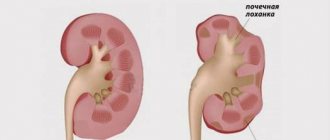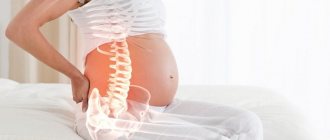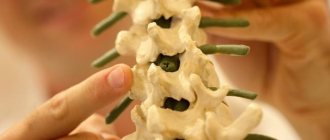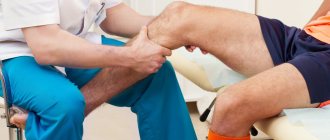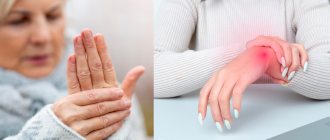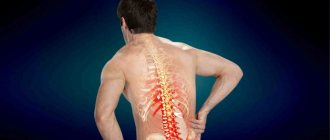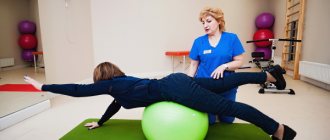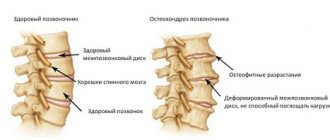Back pain
- a common complaint. Usually we talk about back pain when pain is felt in the lumbar region. Sometimes in such cases they say that “the back is pinched.” According to recent studies, out of every five people, four have experienced such pain at least once in their lives. Read more about lower back pain>>>
Another typical location of back pain is under the right or left shoulder blade or between the shoulder blades. Read more about pain under the shoulder blade>>>
With age, back pain is more common - among older people, every second person experiences such pain from time to time.
Back pain can have a different character: it can be sharp, stabbing, burning, aching, pulling, and can radiate to other parts of the body (for example, to the chest, legs, abdomen, genitals). The pain may be occasional or constant.
When listening to pain, a person usually asks himself two questions: should he see a doctor, and which doctor should he go to for back pain? Let's try to answer these questions.
Character of pain above the lower back
The pain can be chronic, acute, nagging, accompanied by numbness or tingling. It also differs in intensity - from barely noticeable to unbearable, when even a small movement leads to severe discomfort:
- Sharp, “shooting” pain in the lower back and above indicates pathologies of the spinal column.
- Lower back pain, radiating to the sides just above the lower back, accompanies diseases of the musculoskeletal system. This also includes injuries, serious degenerative processes in the spine, and rheumatological ankylosing spondylitis.
- Discomfort when inhaling indicates the presence of intercostal neuralgia.
- When moving, pain occurs in cases of osteochondrosis, damage to the intervertebral discs. Sometimes they can spread to the groin area and lower extremities. An increase in unpleasant sensations is observed with increased physical activity.
- Local pain areas accompanied by numbness of the limbs indicate a compression injury to the spine.
- Chronic pain, independent of body position and stress, accompanied by weight loss should alert you - this is a common symptom of tumors in the spine. It is typical that when taking painkillers in this case, the pain still remains.
- Constant “shooting” pain in the lower back and above, increased temperature is a sign of infectious inflammation in the spinal column. A blood test will help determine this.
- Girdle pain above the lower back, radiating to the collarbones and under the shoulder blades, is a signal of an attack of acute pancreatitis. An additional symptom may be vomiting.
- Intense pain in the thoracic region, radiating to the area above the lower back, tachycardia, are a sign of an aortic aneurysm.
- In the area of the shoulder blades there is a sharp, nagging, throbbing pain in various locations (under the shoulder blade, on the left, between the ribs) that varies in duration (periodic, with a sharp onset, intensifying). The main causes are: intercostal neuralgia, angina pectoris, osteochondrosis, scapular-costal syndrome or gastric ulcer.
Often pregnant women complain of back pain above the lower back. This is due to the increasing load on the spine and a possible shift in the woman’s center of gravity. Women who, before pregnancy, had osteochondrosis, curvatures of various types, and poorly developed muscle corset are especially susceptible to back problems.
Gynecological problems
Female anatomy is such that pathologies of the genital organs affect the lower back more than the abdominal area. After all, the female organs are located in the middle part of the small pelvis.
In addition to the accompanying symptoms, during gynecological diseases the lower back is pulled. There are many reasons for women to worry when nagging pain appears.
Inflammation of the ovaries and appendages
Don't sit in the cold, otherwise you'll catch a cold
. How often have you heard this warning from mothers? But the cause of female inflammation is not cold at all, but infections. Low temperature still plays a role - it weakens the body's protective functions.
Although inflammatory processes usually develop with frequent changes of sexual partners and reluctance to use a condom.
Adnexitis (the medical name for inflammation of the ovaries) is provoked by staphylococci, gonococci, chlamydia, trichomonas, ureaplasma, mycoplasma and other viruses, bacteria and fungi.
The destructive activity of pathogenic microorganisms leads to abortion and infertility.
Classic signs of inflammation of the ovaries and appendages are:
Advertising:
- sharp pain in the lower abdomen, radiating to the lower back;
- increased body temperature;
- yellowish vaginal discharge;
- discomfort during sexual intercourse;
- frequent urge to go to the toilet;
- menstrual irregularities.
If left untreated, the disease becomes chronic. The ovaries enlarge and adhesions grow. With acute inflammation, there is a risk of complications.
Signs of endometriosis
The disease is characterized by growth of the inner layer of the uterine wall, moreover, outside the endometrium. Such growths are sensitive to female hormones that affect the menstrual cycle. Every month, bleeding appears in them, which causes inflammation of the surrounding tissues.
This is why endometriosis develops in women of reproductive age and is accompanied by symptoms:
- pain in the abdomen and lower back, especially during menstruation;
- more heavy and prolonged menstrual bleeding;
- painful sensations during sexual intercourse;
- infertility.
Laparoscopy is performed to confirm the diagnosis. Ultrasound in this case is considered ineffective.
Ectopic pregnancy
For women, this diagnosis sounds like a death sentence - it is so dangerous, sometimes fatal. After fertilization, the egg is implanted not in the uterus, but in the ovary or fallopian tube.
Here it begins to grow, stretching the organ, which is not suitable for bearing a child. There comes a moment when he simply breaks into pieces.
In the early stages, an ectopic pregnancy is accompanied by the usual signs of pregnancy (delay, nausea, swelling of the mammary glands) and is no different from a uterine pregnancy.
Suspicion of pathology may arise when symptoms appear:
- the lower abdomen hurts, but only on one side - right or left;
- pulls the lower back;
- rarely, but uterine bleeding occurs (usually it occurs in the abdominal cavity);
- the skin turns pale;
- blood pressure drops;
- a frequent weak pulse is felt.
The final diagnosis is made after an ultrasound scan.
Menstrual pain
Rarely a woman can talk about painless periods. Some representatives may even lose their ability to work for a couple of days due to:
Advertising:
- severe cramps in the lower abdomen;
- nagging pain in the lower back;
- nausea;
- dizziness;
- general weakness.
But this is not the only painful moment of the menstrual cycle. Discomfort is also felt during ovulation, when the egg is released from the follicle.
Back pain above the lower back: causes
If your back hurts above the lower back, the cause may be various diseases or injuries:
- Thoracic osteochondrosis.
- Thoracic injury.
- Muscular myositis.
- Kyphosis, thoracic scoliosis.
Sometimes the cause of discomfort can be sciatica - pinching of the sciatic nerve due to muscle spasm (including piriformis), osteochondrosis, or the last trimester of pregnancy. Pain above the lower back can radiate to the back, neck, and below - to the buttock or leg. Each cause needs diagnosis to avoid complications. There are other factors that influence the occurrence of pain:
- Genetic predisposition.
- General and local hypothermia.
- Sudden physical activity.
- Features of the profession (presence of vibrations, loads, sitting posture).
- Distortion of posture.
- Excessive weight, metabolic disorders.
- Infectious diseases of the gastrointestinal tract.
- Osteoporosis.
- Diseases of the pelvic organs.
- Poor diet, bad habits.
- Tumors.
The exact localization of pain is of great importance in making a diagnosis, which can only be determined by a qualified doctor.
Diagnostic measures
It is impossible to make a diagnosis without undergoing an examination, and even less so for yourself. After all, similar clinical manifestations can be the result of completely different diseases. It is for this purpose that a specialist prescribes a comprehensive examination.
There is no need to engage in self-diagnosis; a qualified specialist will not only prescribe the necessary examination, but also select a set of treatment measures
Diagnostics includes the following methods:
- general blood and urine analysis;
- blood chemistry;
- ultrasound examination of the abdominal cavity, pelvic organs and kidneys;
- Vascular ultrasound;
- gynecological smear;
- x-ray of the pain location;
- if necessary, CT or MRI, electromyography, scintigraphy.
All these types of studies can be carried out in a medical center that has special equipment and reagents. Only on the basis of the data obtained, the doctor makes an accurate diagnosis and prescribes effective treatment.
Diseases of internal organs
Back pain on the right side is an “alarm bell” of lung damage and possible infection of the pleura. An additional symptom is shortness of breath. Sometimes unpleasant sensations can appear on the left side. Morning pain above the lower back may not always be a sign of spinal disease. Sometimes the cause may be kidney disease and even myocardial infarction.
Night pain in the back above the lower back is a sign of gastrointestinal diseases, stomach ulcers, colitis, pancreatitis or tumors. Often the unpleasant sensation is of a girdling nature.
Muscle diseases
Muscle diseases are also often accompanied by diseases of the lower back and overlying areas:
- Myositis is inflammation of the lumbar muscles. Accompanied by aching pain. Usually occurs after hypothermia.
- With injury or heavy physical activity, pain in the lower back often occurs, ranging from mild to cutting. Staying in one position for a long time is also often the cause of this unpleasant phenomenon.
- Overexertion and muscle spasms are a consequence of sedentary work and a sedentary lifestyle.
To understand whether the pain is temporary or is it a serious inflammation, it is necessary to undergo a diagnosis.
Arthrosis and osteochondrosis
Arthrosis is a joint disease that manifests itself most intensely in the morning. In the early stages, after a short warm-up, the unpleasant sensation subsides. But in an advanced stage, pain can become a constant companion, intensifying every day. Arthrosis is usually attributed to age-related changes when metabolism in cartilage tissues is disrupted. Existing osteochondrosis aggravates the course of the disease. Thoracic osteochondrosis is a fairly rare occurrence. It can occur for various reasons:
- As a result of injury or surgery.
- With a sedentary lifestyle.
- As a consequence of arthritis or spondylitis.
- With existing osteochondrosis of other parts of the spine.
Arthrosis also gives a persistent feeling of discomfort and is characterized by periodic pain radiating to the thoracic region and lateral areas.
Complications and consequences
It is highly not recommended to neglect diseases associated with the spine and back. Even slight discomfort in this area can lead to serious complications:
- If the spine is severely deformed, compression of the nerve roots may occur. The result is numbness of the limbs and complete paralysis. This happens in advanced cases of intervertebral hernia.
- Back pain often serves as a signal for the onset of pyelonephritis. Untreated disease is fraught with tissue necrosis.
- Loss of flexibility in the lumbar region occurs due to chronic injuries and myositis.
Chronic pain syndrome is practically not relieved by painkillers, so it is better to take preventive measures than to get constant excruciating pain. Unfortunately, discomfort in the lower back can “mask” serious diseases, such as kidney stones, acute inflammation of the intestines, rupture of a cyst in a woman, or inflammation of the ureter. In some cases (less than 4%), pain in the lower back may be associated with nerve damage (more precisely, the spinal nerve root). Previously, this disease was called radiculitis (today - radiculopathy). In rare cases, surgery may be required.
3 Comparison of pathologies
Knowing the characteristic manifestations of kidney and lumbar spine diseases, it is possible to correctly differentiate. There are a number of symptoms that suggest one or another pathology:
| Lumbar | Kidneys |
| Acute, persistent pain | Aching pain of increasing nature |
| Temperature is normal | Hyperthermia |
| Increased symptoms when changing body position | Constant intensity of symptom manifestation, which does not depend on movement |
| Urine values are normal | Impurities of blood, pus, mucus in the urine |
| The positive effect of using medications with a warming effect that relieve pain | Inability to relieve symptoms with warming and anti-inflammatory creams and ointments |
Back pathologies are characterized by muscle spasms in the affected area, burning, and redness. When the kidneys hurt, there is a feeling of heaviness, one-sided localization is typical, Pasternatsky syndrome is positive. You can check its presence at home.
Parenchymal kidney cyst: causes, symptoms and methods of treating the disease
Prevention of pain above the lower back
To avoid pain, you should follow simple recommendations:
- Comfortable sleep is the key to back health. The position should be comfortable, and the pillow and mattress should be of medium hardness. Ideally, they will be orthopedic.
- Compliance with safety precautions during sports training, especially if they are carried out under load.
- The ability to maintain posture has a positive effect on muscle tone and the health of the spine in general.
- Regular walking will help keep your back muscles toned, which will eliminate many problems.
- Maintaining a sleep and rest schedule.
- Good nutrition in moderation.
If lower back pain lasts more than 3 days, you should not self-medicate - you should definitely consult a doctor.
Recommendations
In some cases, by paying due attention to your health, back problems can be prevented. To do this, just remember a few tips:
- Take your child to an osteopath for a routine examination, even in the absence of complaints, at the age of one month, in order to promptly identify and eliminate disorders that have formed in utero or during childbirth.
- If a child falls on his tailbone, sacrum or back, it is worth ruling out a fracture of the pelvic bones or spine, for example, using x-rays. Then, if there is no fracture, it is recommended to visit an osteopath in order to promptly eliminate the consequences of the injury on the body. In the event of a fracture, it makes sense to immediately contact a traumatologist, and one to two weeks after the injury, contact an osteopath to speed up healing and prevent the consequences of injury for the entire body.
- During the active growth of a child, it is important to pay due attention to the condition of the back and posture. Regularly undergo preventive examinations with an orthopedist and osteopath.
- During pregnancy, women are advised to visit an osteopath (optimally at the beginning of the second trimester) to prevent exacerbation of chronic diseases in later stages, as well as to prevent labor disturbances.
- After childbirth, you should not neglect physical therapy exercises. This will help the body recover faster after pregnancy and reduce the risk of possible complications.
Did you like the article? Add the site to your browser bookmarks
